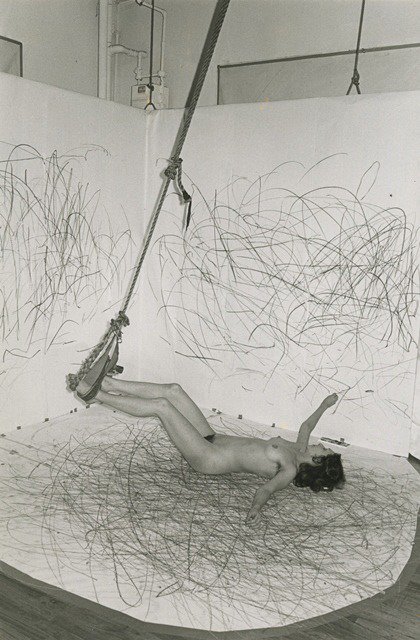Carolee Schneemann
dal 19/11/2015 al 27/2/2016
Segnalato da
19/11/2015
Carolee Schneemann
Museum der Moderne, Salzburg
Kinetic Painting. a comprehensive retrospective of the work of the American artist. Surveying an oeuvre that spans six decades, the show traces a genealogy of new forms of art that emerge as painting set in motion.

Curators: Sabine Breitwieser, Director, Museum der Moderne Salzburg; Consulting Curator: Branden W. Joseph, Frank Gallipoli Professor of Modern and Contemporary Art, Columbia University, New York; with Tina Teufel, Curator, Museum der Moderne Salzburg.
Reserving two floors of its Mönchsberg building for the
work of Carolee Schneemann (b. Fox Chase, Pennsylvania, 1939, lives in New Paltz,
New York), the Museum der Moderne Salzburg mounts a comprehensive
retrospective of her oeuvre to pay tribute to a leading artist of her generation.
Historians of twentieth-century art know Schneemann as a pioneer of performance
art, and her seminal engagement with gender, sexuality, and the use of the body has
been a major influence on generations of younger artists. The Museum der
Moderne’s exhibition focuses on both canonic pieces and performances, and
previously unpublished and rarely-seen works that showcase lesser-known aspects
of Schneemann’s prolific output. “Based on a thorough scholarly review, the
retrospective presents her oeuvre in unprecedented breadth and depth, embedding it
in the context of painting and encouraging a wider audience to explore her art,”
Sabine Breitwieser, director of the Museum der Moderne Salzburg and the
exhibition’s curator, emphasizes. Starting with Schneemann’s early landscapes and
portraits of the mid-1950s, which evolve into distinctive objects for which she coined
the term Painting Constructions, the exhibition investigates the role of painting in
connection with her performances, choreography, and experimental films. Covering
18,300 sq ft of exhibition space, the exhibition includes around 350 works, including
loans from the Museum of Modern Art, New York, the Tate, London, and
Schneemann's archives in the special collections of the Stanford University Libraries.
Carolee Schneemann studied painting at Bard College, Columbia University, and the
University of Illinois. Early on, she started setting her paintings in motion using simple
mechanisms and integrating photographs and everyday objects into her Painting
Constructions. The exhibition features numerous examples of this genre, in which the
artist also pioneered the use of fire as a creative material; some of them have never
been on public display. In 1961, Schneemann moved to New York and threw herself
into the downtown arts scene, contributing to avant-garde film and dance projects,
happenings, and events. She was in the cast of Claes Oldenburg’s Store Days
(1961), was the first visual artist to choreograph for the Judson Dance Theater
(1962–1964) and appeared as Manet’s Olympia in Robert Morris’s Site (1964).
Aiming to take painting beyond the canvas and to be “both image and image-maker,”
she created a hybrid performance photography by melding her body into an
environment that included Four Fur Cutting Boards (1962) to produce Eye Body: 36
Transformative Actions for Camera (1963).
Many of Schneemann's works and texts focus on the female body in its social and
historical contexts and explore eroticism and sexual pleasure from a female
perspective. Her sexually explicit film Fuses (1965) portrayed herself and her partner,
the composer and music theorist James Tenney, in the midst of lovemaking that
revealed a mutual intimacy and subverted the tropes of mainstream pornography.
Interior Scroll (1975/1977), one of her most renowned works, posits the artist’s body
as a wellspring of “interior” knowledge: inch by inch, she pulls a paper scroll from her
vagina and reads a monologue from it decrying the sexism and disparagement that
women confront in the worlds of art and experimental film. Perhaps her best known
work is the pioneering “kinetic theater” piece Meat Joy (1964), an opulently ecstatic celebration of sexuality, pop music, and flesh. Turning back to cast a critical eye on
the painting of the abstract expressionists, she developed Up to and Including Her
Limits (1973–1977), a performance installation that highlights the artist’s body as a
medium of artistic mark making. Recent works such as the sculpture installation
Flange 6rpm (2011–2013) attests to Schneemann’s undiminished creative energy.
The catalogue Carolee Schneemann. Kinetic Painting I Carolee Schneemann.
Kinetische Malerei will be published in conjunction with the exhibition in separate
German and English editions. The major new catalogue and is the first of its kind on
Carolee Schneemann’s art is edited by Sabine Breitwieser for the Museum der
Moderne Salzburg and includes essays by Sabine Breitwieser, Branden W. Joseph,
Mignon Nixon, Ara Osterweil, and Judith Rodenbeck as well as selected writings by
Carolee Schneemann.
Separate German and English editions, hardcover, 280 x 240 mm, 320 pp., Munich:
Prestel.
Symposium Carolee Schneemann. Kinetic Painting
Saturday, November 21, 2015, 2.30–7 p.m.
Mönchsberg Auditorium
Image: Up to and Including Her Limits, 1973-1977, Documentation of the performance at the Kitchen, New York, USA, February 13-14, 1976, Gelatin silver print, 10 x 8 in. (25.4 x 20.32 cm), Courtesy of C. Schneemann and P.P.O.W Gallery, New York, Photo: Alan Tannenbaum, © Carolee Schneemann, © Bildrecht, Wien, 2015
Press contact:
Hannah Zundel T +43 662 842220-601 M +43 664 8549983 e-mail: hannah.zundel@mdmsalzburg.at
Preview and press conversation: Friday, November 20, 2015, 1 p.m.
Museum der Moderne
Mönchsberg 32 5020 Salzburg Austria
Hours:
Tue through Sun 10am–6pm
Wed 10am–8pm
During the Salzburg Festival also Mon 10am–6pm
Admissions:
Regular € 8
Reduced € 6
Families € 12
Groups € 7



